Affordable storage for the SME, part one
by Johan De Gelas on November 7, 2007 4:00 AM EST- Posted in
- IT Computing
I/O Meter
IOMeter is an open source (originally developed by Intel) tool that can measure I/O performance in a large variety of ways: random, sequential, or a combination of the two; read, write, or a combination of the two; in blocks from a few KB to several MB, etc. IOMeter can generate the workload and measure how fast the I/O system performs. To see how close we can get to the limits of our interface, we did one test with RAID 0.
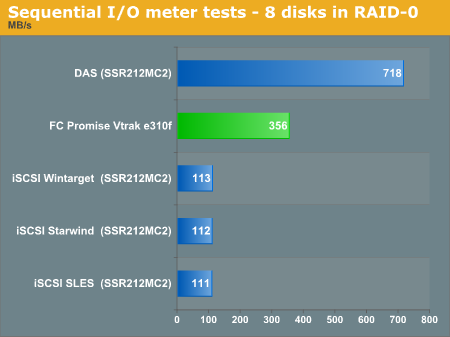
Considering that one of our Fujitsu 15000 RPM SAS disks can do a bit more than 90MB/s, 718MB/s is about the maximum performance we can expect. The iSCSI and FC Channel come close to maxing out their interface, 125MB/s and 400MB/s respectively.
Using RAID 0 for running databases is not a good practice, given the potential for data loss, so from now on we'll test with RAID 5. The next test is the fastest way to access the database: reading sequentially.
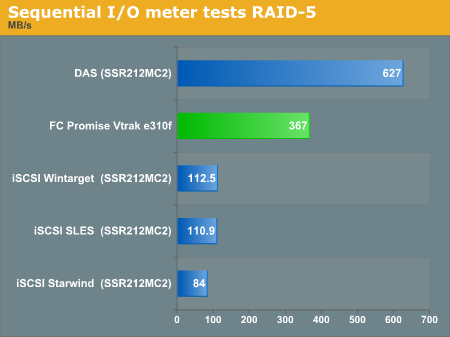
Again, the Intel IOP333 in our DAS does not let us down. Seven striped disks should achieve about 630MB/s, and our DAS configuration comes very close to this theoretical maximum. The interface speed bottlenecks the other setups. Only the StarWind target starts to shown that it's a lower performance offering.
If we read randomly, the disk array has to work a lot harder.
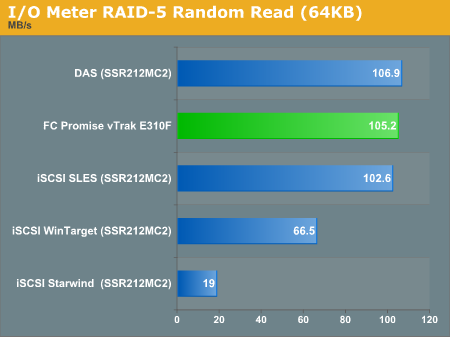
The iSCSI StarWind target gives up, as it cannot cope with a random access pattern. It performed rather badly in other tests too. To reduce the number of tests, we did not include this iSCSI target in further testing.
This is where the iSCSI SLES target shines, delivering performance that is equal to DAS and FC setups. With random accesses, it is little surprise that the larger cache of the Promise VTRAK doesn't help. However, we would have expected a small boost from the newer Intel IOP341 used in the Promise Appliance.
Some applications write a lot to the disks. What happens if we do nothing but writing sequentially or randomly?

The large 512MB cache of the Promise VTRAK E310f pays off: it is capable of writing almost at the maximum speed that its 4Gb/s interface allows. The smaller 128MB cache that we find on the controller of our Intel SSR212MC2 is about 15% slower. Microsoft's iSCSI is about 38% faster in sequential writes than the iSCSI target that comes with SUSE's SLES 10 SP1.
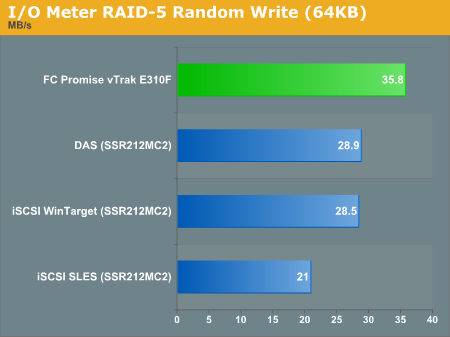
A similar advantage for the Microsoft iSCSI target exists in the random write benchmark. The way Microsoft's initiator sends off the blocks to the iSCSI target is apparently helping in this type of test. The VTRAK E310f is the winner again. This is clearly not a result of its faster interface, but probably a consequence of the newer Intel IOP processor.
An OLTP database and other applications will probably do a mix of both reading and writing, so a benchmark scenario with 66% reading and 33% writes is another interesting test.
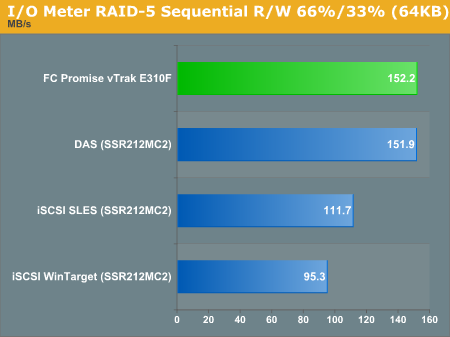

In this case, the Linux iSCSI target is about 20% faster than the Microsoft iSCSI target. The Linux iSCSI target is quicker in random reads, mixing reads with writes but a lot slower than the Microsoft target when doing nothing else but writing. It will be interesting to research this further. Does Linux have a better I/O system than Windows, especially for reads, or is the SLES iSCSI target not optimized well enough for writing? Is using a Microsoft initiator a disadvantage for the Linux iSCSI target? These questions are out of the scope of this article, but they're interesting nonetheless.
The Promise VTRAK E310f has won most of the benchmarks thanks to the larger cache and newer IOP processor. We'll update our benchmarks as soon as we can use a newer RAID controller in our Intel system based on the IOP341.
IOMeter is an open source (originally developed by Intel) tool that can measure I/O performance in a large variety of ways: random, sequential, or a combination of the two; read, write, or a combination of the two; in blocks from a few KB to several MB, etc. IOMeter can generate the workload and measure how fast the I/O system performs. To see how close we can get to the limits of our interface, we did one test with RAID 0.

Considering that one of our Fujitsu 15000 RPM SAS disks can do a bit more than 90MB/s, 718MB/s is about the maximum performance we can expect. The iSCSI and FC Channel come close to maxing out their interface, 125MB/s and 400MB/s respectively.
Using RAID 0 for running databases is not a good practice, given the potential for data loss, so from now on we'll test with RAID 5. The next test is the fastest way to access the database: reading sequentially.

Again, the Intel IOP333 in our DAS does not let us down. Seven striped disks should achieve about 630MB/s, and our DAS configuration comes very close to this theoretical maximum. The interface speed bottlenecks the other setups. Only the StarWind target starts to shown that it's a lower performance offering.
If we read randomly, the disk array has to work a lot harder.

The iSCSI StarWind target gives up, as it cannot cope with a random access pattern. It performed rather badly in other tests too. To reduce the number of tests, we did not include this iSCSI target in further testing.
This is where the iSCSI SLES target shines, delivering performance that is equal to DAS and FC setups. With random accesses, it is little surprise that the larger cache of the Promise VTRAK doesn't help. However, we would have expected a small boost from the newer Intel IOP341 used in the Promise Appliance.
Some applications write a lot to the disks. What happens if we do nothing but writing sequentially or randomly?

The large 512MB cache of the Promise VTRAK E310f pays off: it is capable of writing almost at the maximum speed that its 4Gb/s interface allows. The smaller 128MB cache that we find on the controller of our Intel SSR212MC2 is about 15% slower. Microsoft's iSCSI is about 38% faster in sequential writes than the iSCSI target that comes with SUSE's SLES 10 SP1.

A similar advantage for the Microsoft iSCSI target exists in the random write benchmark. The way Microsoft's initiator sends off the blocks to the iSCSI target is apparently helping in this type of test. The VTRAK E310f is the winner again. This is clearly not a result of its faster interface, but probably a consequence of the newer Intel IOP processor.
An OLTP database and other applications will probably do a mix of both reading and writing, so a benchmark scenario with 66% reading and 33% writes is another interesting test.


In this case, the Linux iSCSI target is about 20% faster than the Microsoft iSCSI target. The Linux iSCSI target is quicker in random reads, mixing reads with writes but a lot slower than the Microsoft target when doing nothing else but writing. It will be interesting to research this further. Does Linux have a better I/O system than Windows, especially for reads, or is the SLES iSCSI target not optimized well enough for writing? Is using a Microsoft initiator a disadvantage for the Linux iSCSI target? These questions are out of the scope of this article, but they're interesting nonetheless.
The Promise VTRAK E310f has won most of the benchmarks thanks to the larger cache and newer IOP processor. We'll update our benchmarks as soon as we can use a newer RAID controller in our Intel system based on the IOP341.










21 Comments
View All Comments
microAmp - Wednesday, November 7, 2007 - link
I was just about to post something similar. <thumbsup>